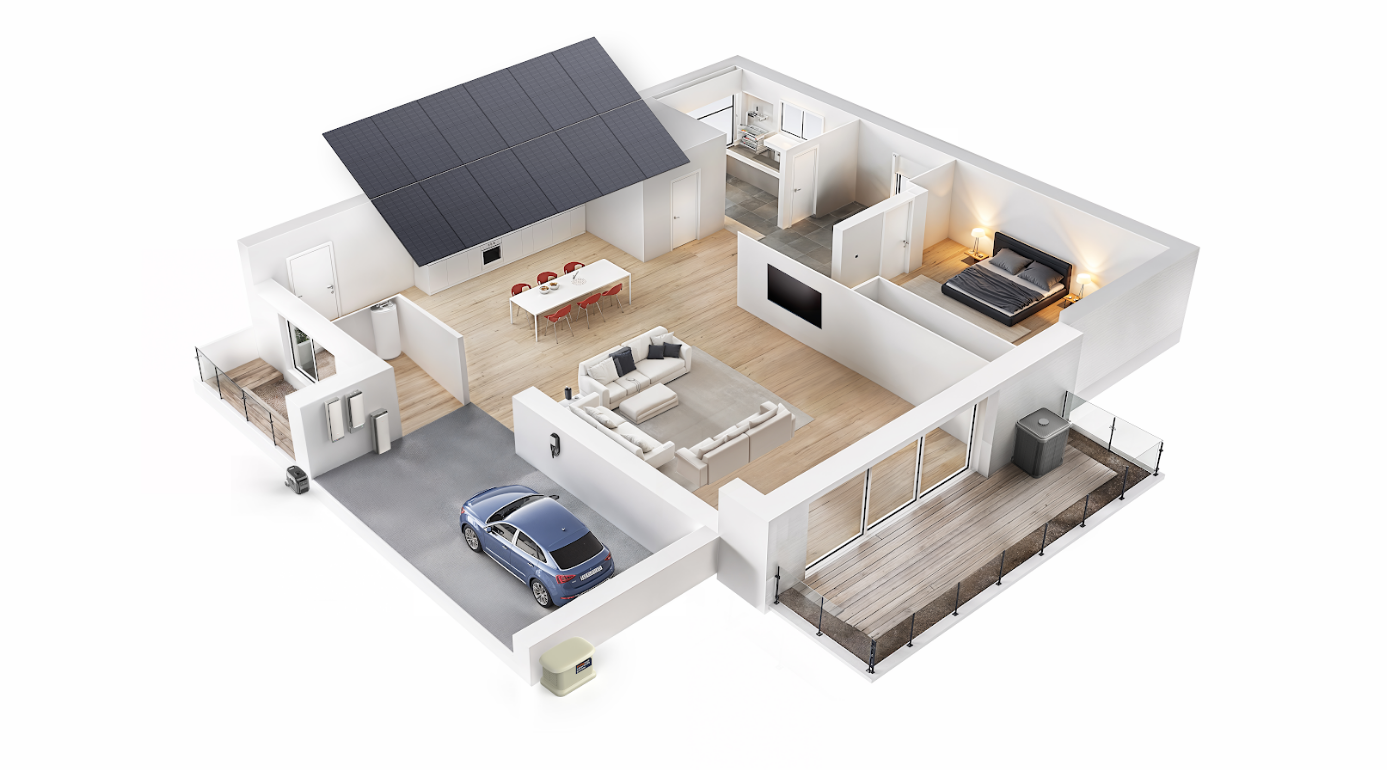How Soon Can You Break Even on a Whole-house Solar Battery System?
Electric bills in Florida are rising fast. Many people now pay around 15 cents per kWh, and that price is expected to grow each year. The average home in Florida uses 1,640 kWh every month. That means a typical family now spends about $247 per month on electricity.
Florida Power & Light (FPL) has already proposed a multi-year rate hike. If approved, the average residential bill will go up $8.39 more per month by 2029—and that’s only the base rate. Other extra fees could grow even more.
So, is a solar battery storage system worth it?
What You Need to Know First
Before doing the math, you need a few key facts:
| Category | Value |
| Florida Electricity Rate | 15.09¢ per kWh |
| Monthly Usage | 1,640 kWh |
| Average Monthly Bill | ~$247 |
| Projected Rate Increase | Up to 20–25% by 2029 |
| Federal Solar Tax Credit | 30% of total system cost |
| Common Battery Size (Example) | 10 kWh |
We will use these values to calculate when a 10 kWh home battery system may break even in Florida.
How Much Does a 10 kWh Battery System Cost?
A full solar battery storage system includes the battery, installation, and related hardware like control panels or inverters. Costs vary, but for a 10 kWh system, you can expect:
| Item | Estimated Cost |
| Battery (10 kWh) | $9,500 |
| Installation + Labor | $2,500 |
| Electrical Upgrades + Fees | $1,000 |
| Total Before Tax Credit | $13,000 |
| Federal 30% Tax Credit | -$3,900 |
| Final Net Cost | $9,100 |
You only pay around $9,100 after the 30% federal tax credit.
How Much Can You Save Each Year?
Savings depend on how you use the solar battery. Many homes use batteries to avoid expensive peak-hour electricity and to protect against power outages.
In Florida, electric bills are expected to increase. But even at today’s rates:
| Calculation | Value |
| Monthly kWh offset by battery | ~300–400 kWh (from stored solar) |
| Savings per kWh | 15.09¢ (today) up to 18–19¢ (in 5 years) |
| Monthly savings | ~$55–$65 |
| Annual savings | ~$660–$780 |
The battery won't cover the full home use, but it helps reduce a large part of your evening or backup usage, when electricity rates are higher.
Other Benefits That Add Value
Even if your monthly bill savings alone don’t recover the cost quickly, there are other financial and lifestyle gains to consider:
Protection from Power Outages
Florida is known for hurricanes and grid failures. A battery gives you reliable power for lights, fridge, Wi-Fi, and security when the grid fails.
Many homes lose over $500 per year from spoiled food and lost work time due to outages. A battery reduces that risk.


Time-of-Use Rate Protection
Utilities like FPL are shifting to “time-of-use” pricing. That means electricity will cost more during busy hours. A battery can help you shift your usage to cheaper times, reducing your exposure to these future pricing changes.
Higher Home Value
Studies show solar systems can raise home value by 4–6%. Homes with solar and batteries sell faster and at a premium. For a $400,000 home, that could mean $16,000–$24,000 added value. This adds another indirect return on investment.
Realistic Break-even Timeline
Let’s add everything up in a simplified model:
Year | Annual Savings (Direct + Indirect) | Cumulative Savings | Remaining Cost |
1 | $700 (electricity only) | $700 | $8,400 |
2 | $730 | $1,430 | $7,670 |
3 | $760 | $2,190 | $6,910 |
4 | $800 | $2,990 | $6,110 |
5 | $850 | $3,840 | $5,260 |
6 | $900 | $4,740 | $4,360 |
7 | $950 | $5,690 | $3,410 |
8 | $1,000 | $6,690 | $2,410 |
9 | $1,050 | $7,740 | $1,360 |
10 | $1,100 | $8,840 | $260 |
So in about 9–10 years, a 10 kWh solar battery storage system can fully pay for itself, using just the direct savings from electric bills.
If you count outage savings and home value increase, the break-even point may come even sooner—around 6 to 8 years.
What If You Use More Power?
If your family uses more than 1,600 kWh per month, you may need a bigger battery, something like 13.5 to 20 kWh. This applies to larger homes, families with many appliances, or houses that use electric heating or cooling year-round. A larger battery will cost more at the beginning, but it also stores more energy and replaces more grid power. That means your monthly savings will also grow. Even with the higher cost, most families can still break even in 8 to 12 years. If your energy use grows over time—like adding an electric vehicle or more air conditioning—you don’t need to start over. A system like the EcoFlow OCEAN Pro lets you expand from 10kWh up to 80kWh as your needs grow, without changing your entire setup.
What Helps You Reach Break-even Faster?
There are smart ways to shorten your payback time. The faster your battery saves money, the sooner it pays for itself.
- Use Appliances Smartly
Try to run large devices—like washing machines, dryers, or water heaters—when your battery is full. Don’t use them during peak hours when electricity is expensive. Smart scheduling can save hundreds per year.
- Apply for Local Incentives
Besides the 30% federal tax credit, some Florida cities and utilities offer extra support. These may be one-time rebates or ongoing bill credits. They can lower your upfront cost and improve your return.
- Avoid Unnecessary Energy Waste
The less energy you waste, the more your battery can cover. Switch to LED lights, high-efficiency appliances, and smart thermostats. Even small changes—like unplugging unused devices—can stretch your stored energy further.
- Track Prices and Upgrade When Needed
If electric rates rise faster than expected (as they are now in Florida), your battery saves more money each month. Some systems also let you add solar, more battery units, or smart features over time. Stay updated, and upgrade when it boosts your savings.
What to Watch Out For
Before you install a solar battery storage system, check these items carefully:
Item | Why It Matters |
Battery Warranty | Should be 10 years or longer |
Installer Reputation | Use certified professionals |
Capacity vs Your Needs | Choose a size that fits your home |
Software + Controls | Easy app control saves more power |
Backup Load Planning | Know which circuits stay online |
For homeowners looking for a strong, future-ready solar battery storage system, the EcoFlow OCEAN Pro offers an all-in-one solution that covers both daily energy savings and whole-home backup needs.
Its modular design starts at 10kWh and can expand up to 80kWh, making it suitable for a wide range of homes—from standard family residences to high-demand properties. Built to perform in tough Florida conditions, the system is certified flood-resistant up to 3.3 feet, heat-resistant to 140°F, and rated IP67 for full dust and water protection. Safety features are also comprehensive, with a built-in fire suppression module and an explosion-proof valve.


Beyond hardware, the EcoFlow OCEAN Pro’s integrated smart control system includes real-time energy monitoring, AI-driven savings optimization, and remote support—all backed by a 15-year warranty.
Whether you're preparing for storm season or aiming to cut your electric bill over time, the EcoFlow OCEAN Pro system is designed to grow with your home and deliver dependable performance year after year.
Final Thoughts: Is It Worth It?
A solar battery storage system for your whole house is a serious investment. But in places like Florida, where power bills are climbing and weather events cause frequent outages, batteries are becoming more valuable every year.
With current pricing and tax credits, most families using 10 kWh systems can break even in 9 to 10 years. If you add solar panels, outage savings, or home resale value, that timeline may drop to 6 to 8 years.
For people who want energy control, future-proof savings, and peace of mind during storms, a solar battery, like the EcoFlow OCEAN Pro, is a must-have.